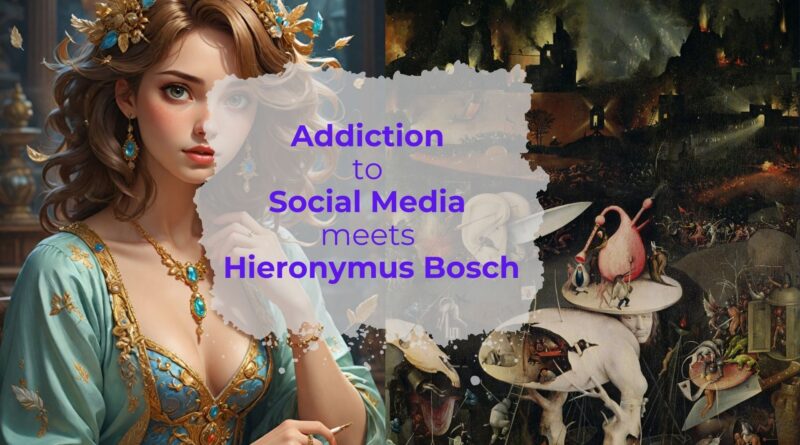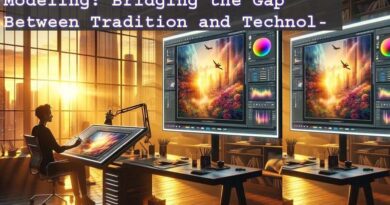What happens when we prompt generative AI to create image of social media addiction?
What happens when we prompt generative AI to create image of social media addiction? And what happens when we try to combine it with a style of famous Hieronymus Bosch’s painting? Interesting stuff.
Introduction: The Effect of Generative AI and Bosch-Style Paintings on Social Media Addiction
The current AI is generative in nature and human-technology interaction is quite different now and especially when it comes to art, images generated using generative AI can provide a new angle to look at social media addiction. As a result, using elements of the Bosch style painting combined with technology, such as generative AI, allows creating an image of a social media addict that can be engaging and meaningful.
In this blog post, the author will consider the impacts of generative AI and Bosch-style paintings to generate an image of social media addiction. It will first explore how generative AI has affected art in general and then showcase how it can be used to create a compelling visual representation of social media addiction.
It will also consider what other factors may further enhance this picture and why they are relevant. Finally, this blog will briefly explain how these combinations could also be employed for additional educational purposes.
To evaluate the likelihood of both generative AI and Bosch-style paintings in depicting social media addiction, one must first assess what generative AI has the capacity to do for art. This allows the creators to have more control over the final outcome because they are the ones who get to determine which patterns should be incorporated into each design.
This type of technology can be used for developing artwork such as landscapes, abstracts or even detailed portraits. When it comes to delivering a message regarding social media addiction, the merger between generative AI and more conventional painting approaches like those seen in the painting by Hieronymus Bosch seems to be the most effective.
By using technology and elements from traditional painting such as color, composition, and texture the viewer is drawn into the work and forced to examine his or her own connection with technology.
How AI to create image that Reflect Social Media Addiction
If one wants to make the work producing an even more powerful statement about social media addiction, then even other elements can be included in the work like using elements like the smartphone or the computer screen or adding a text that can explain it further to the viewers.
Including such elements is useful to draw attention to the multi-faceted problem of social media dependence through additional ways, which are closer to viewers’ everyday experiences compared to a simple picture. The combined use of generative AI and Bosch-style paintings may also assist in offering any educational opportunities for those willing to learn lessons on how digital technologies impact our lives for the better and for the worst at Bosch .
Thus, if the viewers could have been exposed to such visuals they would be in a better position to understand how much their usage habits are affecting them and where changes would have to be made if indeed they wish to engage in moderate usage of social networks. The use of technology in artworks by applying generative AI or works referring to Hieronymus Bosch have proven to be rather effective when it comes to depicting the problems related to, for instance, social media addiction.
These visual have impact and can also include a range of components to make the viewing more profound for the audience, regarding digital culture and similar issues while at the same time, not sacrificing design for information dissemination.
Visual AI has emerged greatly, used to design beautiful and innovative pictures that depict today’s society, more so, the obsession with social media platforms. Using artificial intelligence along with works of art generated by masters of different centuries, tech minds are experimenting and producing images that are reminiscent of the classical art but with a contemporary twist.
Being one of the most famous examples of AI to create image, Bosch-style paintings is one of the most popular applications of generative AI. Similar to Bosch-style paintings, which are dedicated to the famous Dutch painter Hieronymus Bosch and his surreal creations. To produce these paintings, deep learning algorithms of artificial intelligence prompts an image or input to produce a set of images.
This is done in a way that incorporates elements of modern digital art, computer graphics, the use of neural networks, and aspects of classical painting to create an image that embodies the essence of the prompt. The outcomes are usually intricate and interesting artworks that communicate messages of the contemporary society. When it comes to discussing the topic of reflecting our current state of social media addiction, AI to create image helps to view this multifaceted problem as art.
Using an image or a prompt associated with social media addiction, for example, a screenshot of a user profile page or a typical news feed post, the algorithm is able to create a sequence of Bosch-style paintings that describe various sides of this problem. From these paintings one can learn how much this addiction goes and how it affects us on the conscious and subconscious level.
The use of generative AI also brings in other advantages such as the ability to address different aspects of social media addiction that would otherwise not be captured by artwork alone. For example, traditional paintings are normally confined by either the size and shape of canvas available; generative AI can generate as many different variations of a theme or topic as is desired – be it social media dependency – by using its database of algorithms and methodologies.
This enable one to be more innovative especially when it comes to elaboration of this concern through art works. Integration of technology together with art has opened up new ways of tackling problems such as social media dependency that were not possible under conventional forms of art. Artists who want to create artwork based on contemporary events and social issues like this one have now been able to harness the capabilities of generative AI when implementing their ideas.
Discussing the Impact of Generative AI and Bosch-Style Paintings on Public Perception of Social Media Addiction
Facebook addiction is one of the modern realities of life, which affects a significant amount of elderly people. Automated image creation through generative AI has also been employed to develop paintings that portray the experience of ‘Bosch’ in delivering a message on social media addiction to the public. These works, using AI to create image incorporated into art, will make the viewers think about their experiences with social media in an attempt to decipher how it affects them.
I also imply that generative AI and Bosch-style painting is capable of changing the attitude of people towards the problem of social media addiction, as its creation in abstract images make understanding it easier. For instance, they can be employed to elicit discourse regarding the impacts of technology on the society, the commendation aspect as well as the drawbacks. This is even more so given the fact that the digital culture is constantly changing and it is yet to be determined what kind of impact it will have on our mental well-being.
At the same time, these works that offer a critical reflection on social media addiction through generative AI and Bosch-style paintings could also have this counter-function – people get exposed to these creations and start questioning how they interact with the technologies presented to us. In this case, such artworks help guide the viewers into pondering how their own behaviors could be exacerbating the issues depicted or portrayed.
In addition, in making viewers self-reflect about how they interact with social media, generative AI and Bosch-style paintings might also assist and inform individuals in how they could be more appropriately safe in using technology. What we can deduce from the analysis is that it is possible to use technology and art to address the issue of addiction to social media in a way that will influence the public’s perception.
Employing AI to create image or excelling at Bosch-style painting can serve as an opportunity to view this problem from the perspective that has not been considered before. These works proved helpful for they allow us to ponder over our interactions and use of technologies in a conversational manner which is rather important to consider while evaluating our everyday relationships with technology.




